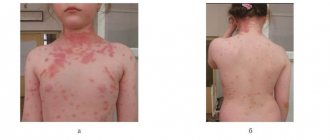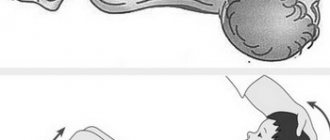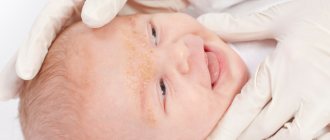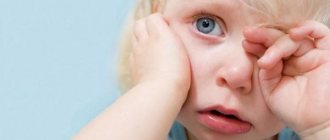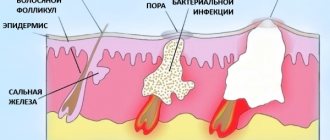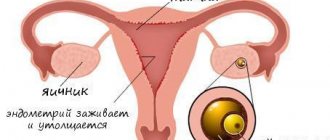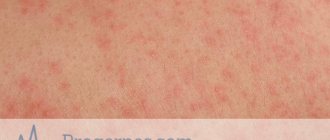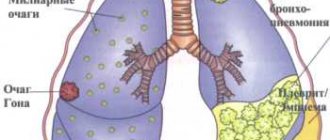The skin of babies is very sensitive - redness, irritation or rashes appear on it every now and then. It is extremely important to recognize the cause of such formations and generally understand what it is. In most cases, parents suspect that this is how an allergic reaction manifests itself - to food, washing powder, pets... But it is quite possible that the reason is different - it may not be an allergy, but lichen in the baby.
Most often, children in the first year of life are affected by ringworm, and less commonly by Zhiber's pityriasis rosea. Each type of this disease has its own treatment regimen; first of all, you should consult a dermatologist to confirm that it is indeed lichen, and also to determine its type.
More articles related to your question
- The baby arches his back: physiological and pathological reasons
- Erythema in a newborn baby: causes, symptoms, treatment
- Heat rash in infants: what do you need to know about it and how to cure it?
- When babies start to roll over: how to teach the baby the necessary skills
- Infant hair: features of the condition, causes of hair loss and care rules
- Milk crust in a baby: is there a reason for concern?
How does it manifest in children?
Ringworm is the general name for a large group of skin diseases of fungal origin. The good news is that infants cannot become infected with all types of lichen. Most often, the skin of infants is affected by ringworm. Dermatologists note that in rare cases, infants can also suffer from pityriasis rosea, although this diagnosis is most often made in children aged 4 to 12 years.
The following symptoms are typical for ringworm:
- spots with a characteristic swelling in the center, have an oval or round configuration;
- itching and slight flaking in the area of the spots;
- since ringworm tends to affect the hair follicles, its favorite localization is the scalp;
- Sometimes ringworm in children under one year of age can be accompanied by fever and swollen lymph nodes.
- Symptoms typical of Zhiber rosea:
- rashes in the form of spots, having clear but uneven edges with swelling and peeling in the center;
- different size spots;
- sore throat, low temperature, headache.
Both ringworm and rosacea have a typical common symptom - the appearance of a maternal plaque at the beginning of the disease, which is larger in size compared to other rashes.
Treatment of lichen on the legs
To treat ringworm, antifungal drugs are prescribed according to the regimen prescribed by the doctor; ointments for local treatment also have antifungal effects; gels can be prescribed, but they are less effective than ointments.
Hormonal creams are extremely rarely prescribed. Treatment will not bring the desired effect if hygiene measures are not observed, and without eliminating the source of infection.
Pityriasis rosea does not require treatment, it often goes away on its own after two months. For a quick recovery, you need to get rid of allergens by choosing the right diet, replacing synthetic items with fabrics of natural composition. In the autumn-spring period, vitamin therapy is indicated.
To select a treatment regimen for lichen planus, it is important to take into account the factors that caused it, treat associated ailments, limit occupational hazards, and remove foci of infections.
The main therapy includes hormonal ointments; if the patient has severe itching, antihistamines are used; when it becomes chronic, solutions and drugs that improve blood supply to the tissues are used.
Treatment for pityriasis versicolor is long, but it is completely possible to cure it. Usually this is a complex of medicines. Keratolytic (exfoliating) drugs, local antimycotic, and sometimes antihistamines are used.
The treatment period is on average about two weeks, if the panacea is chosen correctly, then the symptoms disappear after 3-4 days, but despite this it is very important to continue treatment, if you stop taking the drugs, then everything will resume.
After the lichen has been cured, white spots remain on the skin and are noticeable, but they disappear after several sunbathing sessions.
Shingles is treated with antiviral drugs that neutralize the effect of the virus; additionally, painkillers and sedatives are prescribed, because the itching and pain caused by this type of shingles can disturb sleep.
Ointments and solutions with disinfectant and antiseptic properties are used to act locally on the virus. In severe forms of the disease, corticosteroids may be prescribed, but their use is highly undesirable and is very rarely used due to many side effects.
How does the disease progress in infants?
Rash from lichen can appear anywhere, but most often they affect the skin of the shoulders and abdomen. The legs and scalp are also no exceptions. At the very beginning of the disease, the spots are not bright; they are mostly light pink in color and slightly peel, especially in the center. At this stage, the rash is not accompanied by itching or discomfort.
But if the baby has a weakened immune system, then in addition to manifestations on the skin, his temperature may rise and his lymph nodes may become enlarged. Fortunately, these symptoms are extremely rare.
A single spot or maternal plaque that appears at the first stage can spread throughout almost the entire body within a few days. The spots with this disease tend to increase at a very high speed, but they never merge with each other and have clear contours.
The slight itching that accompanies lichen is usually not very severe and the child, as a rule, does not notice it.
It is almost impossible to independently distinguish lichen from eczema or dermatitis. These diseases are very similar in appearance, but the causes of their occurrence are completely different. Accordingly, the approach to treatment directly depends on the cause of the disease. Therefore, if suspicious rashes appear on your baby’s skin, you should immediately contact a dermatologist. Diagnosis of lichen, as a rule, does not cause difficulties if it is carried out by a specialist.

To begin with, the doctor examines the rash using a special lamp, then sends the little patient to the laboratory, where he is scraped from the lesion.
Treatment
Pathogenic saprophytic fungi, which are the causative agents of the pityriasis form, are present on the body of almost every person. Under favorable conditions, they begin to actively reproduce, and in humans, damage to the upper layer of the epidermis and the appearance of pityriasis versicolor or, as it is also called beach and multi-colored.
Modern medicine quickly copes with problems with the help of drug therapy, however, difficulties arise with the treatment of children and pregnant women.
To know for sure how to treat pityriasis versicolor in children, you need to visit a dermatologist. Sometimes people may perceive skin rashes as normal irritation, because before this there was increased sweating, or they used very fatty oils and creams. But often these factors contribute to the onset of the disease.
It should be noted that children under 10 years of age suffer from the pityriasis form extremely rarely. In older children, the occurrence is associated with natural hormonal changes in the body during irrational mental and physical stress.
For treatment, dermatologists recommend:
- Ointments containing antifungal components (exoderil, clotrimazole, nizoral).
- Keratolics (tar ointment, iodine, salicylic alcohol).
- Complexes of vitamins and minerals.
- Physiotherapy (magnet, quartz, sunbathing).
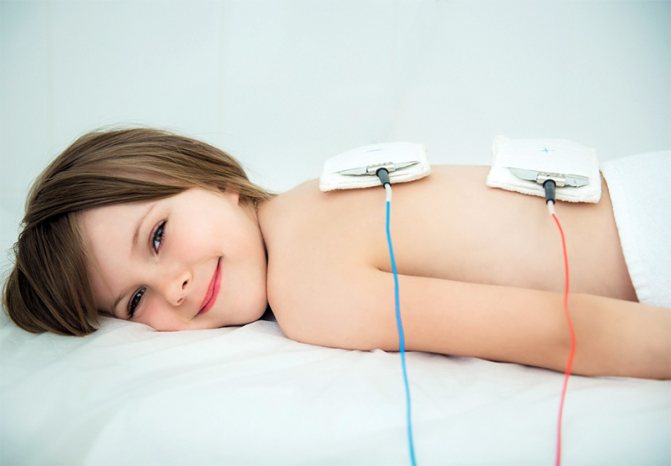
Personal hygiene is important, since a dirty, poorly washed body can cause a long-term illness. Pityriasis versicolor is not contagious; its appearance depends only on individual factors:
- excessive sweating during exercise or when wearing synthetic clothing;
- applying very greasy creams and ointments to the skin without foundation;
- malnutrition;
- diseases that occur with a prolonged increase in temperature;
- the presence of obesity, diabetes mellitus, tumors of various etiologies;
- long-term treatment with hormones and antibiotics.
How are young children treated?
If a newborn baby or an infant under one year old is sick with lichen, treatment should be prescribed only by a doctor and carried out strictly under the supervision of a specialist. Most often, dermatologists use the Demyanovich method. This is the treatment of rashes with an aqueous solution of sodium hyposulfite (60%) followed by treatment with a 6% solution of hydrochloric acid. Dermatologists also use drying agents - Fukortsin, Iodine, etc.
If you have shingles, you should never self-medicate. This is especially true for young children, whose delicate skin requires careful and careful treatment. How to apply the products correctly so as not to cause harm or burn, how many times a day to treat the rash - these and other details are explained in detail by the doctor, whose recommendations should be strictly followed.
What is important to remember during treatment:
- To prevent the rash from spreading throughout the body, bathing the child during treatment is strictly contraindicated.
- Since moisture and heat generated when wearing clothes made of synthetic fabrics can aggravate the course of the disease, during treatment preference should be given to clothing made from cotton and natural fabrics.
- During treatment, you should protect your baby's skin from direct sunlight, which can worsen the condition.
- Since lichen in children takes a very long time to treat, treatment can be stopped only after all skin manifestations have completely disappeared.
Tinea versicolor
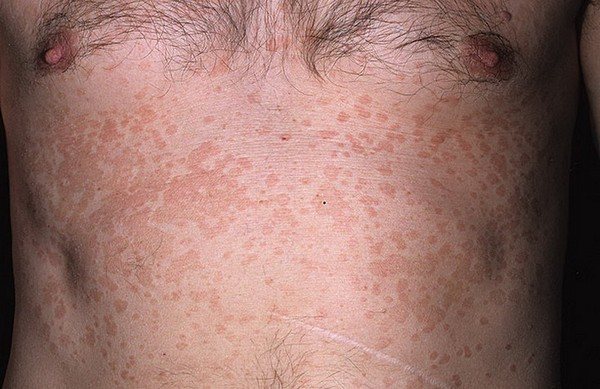
In adolescents and young adults, the pityriasis variety of lichen occurs. The pathology occurs against the background of a chronic fungal infection of the epidermis, its causative agents are Pityrosporum orbiculare, ovale, Malassezia furfur.
Why does the disease develop and how does it manifest? Protozoa microorganisms are part of the permanent microflora of the skin, but when favorable conditions are created, they cause damage to soft tissues. The main symptom of pityriasis versicolor is the formation of round brownish spots that do not darken in the sun, as the fungus attacks the melanocytes that produce the pigment.
The incubation period ranges from 2 weeks to several months. Treatment is carried out with external antifungal ointments and systemic antimycotics. Fungal spores die after 7–10 days, but the spots persist for another 3–6 months; in the hot season, a relapse may occur, which is diagnosed in most patients.
Ringworm is a skin disease caused by fungal infection or viruses. The duration of treatment depends on the type of pathology, the therapy performed, the degree of damage to the dermis and compliance with the doctor’s recommendations. To speed up recovery, it is necessary to follow the rules of hygiene, use medications, wear clothes made from natural materials, and avoid contact with animals and sick people.
Advice from traditional healers
Our grandmothers often treated lichen with ashes from burnt paper. This method has also proven itself very well: a sheet of paper folded into a cone is placed on a plate and set on fire. After combustion, a small amount of brownish content is formed in the center of the plate, which contains quite a lot of birch tar. These contents need to be lubricated on skin rashes.
Traditional healers also recommend making compresses from a specially prepared decoction, which includes burdock, hop cones, plantain and colored violet.
Treatment of weeping lichen
The main treatment of eczema is aimed primarily at eliminating the cause and factors that provoke the disease. For an allergic type of disease, the patient is prescribed a number of antihistamines, vitamins, and immunocorrectors. If the disease manifests itself in severe form, the doctor supplements the therapy with corticosteroid hormonal medications. Often, doctors, depending on the patient’s complaints and the nature of the lesion, prescribe various anti-inflammatory drugs, courses of physiotherapy, acupuncture and even psychotherapy if the disease is caused by nervous tension.
If you notice signs of eczema, consult a doctor!
Ointments
Ointments for the treatment of weeping lichen are used, as a rule, in complex therapy. Among the non-hormonal remedies for relieving itching and swelling, zinc-based drugs are prescribed: Desitin, Tsinadol. Often they use naphthalene and ichthyol-containing creams, sulfur ointment, and Dermalex. For seborrheic form, 2% salicylic acid is often prescribed.
All these ointments are inexpensive, but at the same time they perfectly relieve inflammation and soothe itching. In addition, ichthyol and salicylic agents also have a pronounced anti-inflammatory effect.
Of the hormonal ointments, dermatologists prescribe: “Flucinar”, “Diprosalik” or its analogue “Belosalik”, “Trimistin” and “Hydrocortisone” cream.
Never use hormonal ointments without consulting a doctor.
Pills
For the treatment of patients suffering from tinea versicolor, drugs of various spectrums of action are widely used:
- antihistamines - “Zirtec”, “Telfast”, “Cetrin”, “Kestin”, “Claritin”, “Loratadine”, “Erius”;
- antibiotics - “Gentamicin”, “Tetracycline”, “Erythromycin”, “Ampicillin”, “Lincomycin”;
- vitamins - groups “B”, “A”, “C”, “Perfectil”, “Aevit”.
Antihistamines relieve swelling of the skin, have an antiallergic effect, a sedative, antispastic effect, eliminate itching and irritation. Antihistamines are prescribed to absolutely all patients, regardless of the form of the disease.
Antibiotics are prescribed for microbial types of lichen and in case of bacterial infection. As a rule, such therapy is considered justified when symptoms of complications appear, a high temperature rises and the patient’s condition worsens.
Only a doctor should make a decision about prescribing medications. If you are prescribed an antibiotic and you think it is not needed, consult another specialist, but do not cancel the drug based only on your opinion.
Shampoos
If the scalp is affected by eczema, then specialized shampoos are indispensable. Shampoos such as “Skin-Cap”, “Sebozol”, “Keto+”, “Cinovit”, “Nizoral” are very helpful as an adjuvant in complex treatment. Some of them not only relieve itching and soothe the skin, but also have an anti-inflammatory effect, promote the healing of wounds and microtraumas from scratching.
Diet
In addition to drug treatment, patients with weeping lichen must be prescribed a gentle diet.
A person is allowed to eat:
- dairy products;
- porridge;
- greens, vegetables;
- protein dishes.
It is strictly forbidden to eat during treatment:
- alcoholic products;
- fatty and fried foods;
- fast food.
In addition, the patient should drink a lot. At least 1.5-2 liters of water per day. Water will help quickly remove toxins from the body and avoid dehydration.
Treatment with folk remedies at home
Treatment with folk remedies, as a rule, is resorted to by people who have already tried a lot of medications. Wanting to speed up recovery, they are looking for a way to get rid of the disease on their own, trying everything. There is no need to do this. There are time-tested folk remedies, which are sometimes prescribed even by doctors themselves.
If you have not yet been to a dermatologist, do not start self-medication. Visit a doctor! Be sure to consult with a specialist about the admissibility of certain traditional medicine methods before using them.
Traditional recipes for eczema:
- If you have affected skin on your eyelids or face, prepare a decoction of birch buds. Fill a glass of dry herb with the same volume of boiling water, place on low heat and boil for 15 minutes. After the potion has cooled, soak gauze in it and apply to the sore eyelid for 15 minutes. Repeat the procedure daily 3 times a day until symptoms disappear.
- Pick fresh elderberry leaves. Rinse them well in cool running water. Examine the leaves carefully. Are there any insects or parasites left on them? Apply leaves to problem areas.
- Cut off a Kalanchoe leaf, prepare a thick gauze bandage, and squeeze all the juice onto it. Apply the compress to the painful area and do not remove until all the juice is absorbed into the skin and the bandage is dry. Do this procedure every day, 2 times a day until complete recovery. The bandage can be worn without a break for no more than 4 hours.
- A regular potato mask works well. The root vegetable is grated, the juice is drained, and the pulp is placed on the eczema for 20-30 minutes. This cosmetic procedure should be carried out daily, 2 times a day.
- Prepare a decoction of equal portions of calendula, chamomile and sage. Pour approximately 20-30 g of herb into a couple of glasses of boiling water. Let it brew for 20 minutes. Then soak a gauze bandage in the potion and apply it to your face. The compress should be kept on the skin for no more than 20-30 minutes. The procedure can be repeated up to 2-3 times a day.
Recommendations
During the period of exacerbation of weeping lichen, a person should avoid contact of the affected area with water. You need to provide yourself with the most comfortable psychological atmosphere, lead a healthy lifestyle, walk more, walk more and eat right.
Those suffering from an allergic form of eczema are advised to use only hypoallergenic cosmetics and personal care products. Also, all patients should avoid strong sunlight.
Prognosis and prevention
Since lichen is highly contagious - that is, it is easily transmitted from animals and humans, the room where the sick baby is located should be wet cleaned with disinfectants three times a day. The clothes of a sick child should be washed separately from other clothes and should be ironed thoroughly.
During treatment, soft toys and carpets should be removed: particles of affected skin remain on their surfaces, which can cause another infection and protracted treatment. Toys and carpets should be washed and disinfected whenever possible.
With timely diagnosis and proper treatment, lichen in children can be successfully treated. As a rule, complete recovery is confirmed by a blood test, which is prescribed by the attending physician upon recovery. If everything is done correctly, the prognosis for this disease is favorable.
Prevention
To avoid a relapse after an illness, you should have your blood tested after recovery. Then it will be possible to cancel therapy.
It is possible to cure lichen in children. During your illness, follow a hypoallergenic diet. Children are allowed to eat natural compote, kefir and cottage cheese, yogurt, lean meat and fish, rice, semolina and oatmeal. If you have lichen on your head, cover your head with a panama hat before leaving the house. If the plaques are located on the body, then cover the body. Strengthen your child's immunity. Doctors have proven that children with strong immunity do not develop tinea versicolor, even if the children around them have this disease. To avoid ringworm, parents should ensure that the child does not come into contact with stray animals. It is advisable for pets to be vaccinated.

